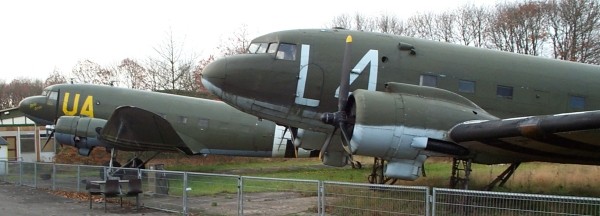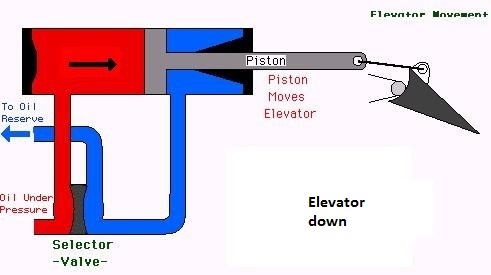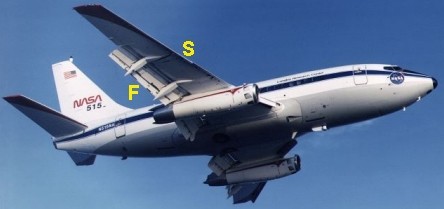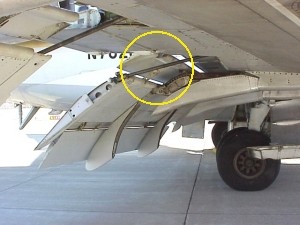
How can a small pilot control such a big aeroplane?

The 1935 Douglas DC-3 (above) is controlled by the
pilot's manual power. The movements the pilots make, are transferred by thin
steel cables running along pulleys (little wheels with a groove in it). In
that way they can move the ailerons, elevator and rudder. The Wrights did it in the
same way. The DC-3 (aka Dakota and C-47 Skytrain) has dual control. There are advantages
in dual control. Whenever the pilots meet adverse weather conditions, they have
to work both on the controls to keep the aeroplane in the air.
Around 1940 aircraft became so big, the pilots were not capable anymore to
control an aeroplane in bad weather. So they needed help and help was available
by means of hydraulic power steering. Hydraulic means that a fluid is used.
Hydraulic fluid. This is used in the brake system of cars, for instance. It
looks like oil, but it isn't. Most of these fluids are based on alcohol.
Hydraulic systems in aviation were well known before 1940. The landing gear of
the DC-3 is operated hydraulically. For such a system a pump is needed which
pumps the hydraulic fluid out of a tank to the actuator. Aeroplanes have redundant
hydraulic systems,
. Often the systems are quadruple because of safety reasons. The hydraulic pumps
are driven by the engines. Then there are tubes or lines to transport the fluid
where it is needed. Last but not least actuators
are applied in the system. They transfer power. How does an actuator work?
|
|
| The selector valve is in such a
position that the hydraulic fluid (red) presses
on top of the piston. The piston retracts and "pulls" the elevator rod. The fluid behind the piston (blue) is pressed away in the direction of the oil storage tank behind the piston. |
 |
| This is the other way around. The
selector valve is in another position and now fluid is pressed behind the piston (red). The piston moves outward and the the elevator rod is "pushed". The fluid on top of the piston (blue) is pressed to the storage tank. |
Well, in these drawings it is shown like an "all or nothing" system. In reality the selector valve is constructed in such a way that it is possible to use small movements. It is important a hydraulic system can react fast, which is paramount in controlling an aeroplane.
As remarked earlier, a hydraulic system is often implemented quadruple. So if a pump fails or a line leaks, enough systems are left to fly on safely. After all, hundreds of lives are at stake. However, such a system with many hydraulic lines would become very heavy. So, still cables are used. Below you can see the ceiling of a Boeing 747 where cables are running from the cockpit to the rear bulkhead and the wings. By doing so, less hydraulic lines are needed from the cockpit to the extremities of the aeroplane. In the end these cables operate hydraulic valves which in turn control the actuators:

The circles show the cables. The greenish stuff is
insulation
for cold and noise.
To keep the weight down, the hydraulic system operates at a high pressure: 200
kilos per square centimeter (3000 psi). That is hundred fold the pressure of a
car tyre. But doing so, the actuators can be rather small and the hydraulic
lines can be smaller too because little fluid is used (all because of the high
pressure). The Airbus A 380 even applies a hydraulic pressure of 350 kg/cm²(5000
psi). In the new Boeing 787 Dreamliner for some controls electric-hydraulic
actuators are used. But the most important system to control the ailerons,
elevator and rudder, still uses the proven hydraulic technology.
All pilots flying big aeroplanes ever had lessons in small aeroplanes. They know that in certain situations you have to pull and push the stick harder. It is just the "feel" when you fly. To simulate that feeling, a device is available to make the controls artificially heavier. So the pilot still has the sensation of really flying.
The hydraulic system is also used to lower and raise the landing gear. It is used too for steering the nose wheel and in case of the 747, the inside main landing gear. For the brakes it is applied as well. Look at the 747:
 |
 |
| In the circle the
actuator which pulls the landing gear to lower it. The rectangle shows the two actuators to retract the landing gear. This is a forward movement, against the airstream, so more force has to be applied to do the job. By the way, we are looking rearwards of the aerpolane. |
Apart from the nose
gear, the inner landing gear can move too. (In a reverse direction compared to the nose gear). So two actuators are used (see inside the yellow circle). The small circle shows the lines that operate the brakes. |
 The
hydraulic system can drive hydraulic motors too. They work different from
actuators, which only can move in and out. They can turn around, like an
electric motor. Some types look like little radial piston engines. Hydraulic motors are used for slow moving purposes.
The
hydraulic system can drive hydraulic motors too. They work different from
actuators, which only can move in and out. They can turn around, like an
electric motor. Some types look like little radial piston engines. Hydraulic motors are used for slow moving purposes.
For instance the slats (S) and the flaps (F).
These devices provide more lift at take off and landing. The photo shows a
vintage Boeing 737. For control of these devices also compressed air from the
jet engines is used. This is called a pneumatic system. The slats of
the Boeing 747 uses such a pneumatic system. That is clever because the engines
that supply this air, are very close! In
this case the motors are turning around like an electric motor too. These
engines turn a giant screw and a very big kind of nut. So the radial movement is
converted to an axial movement.
 |
 |
| When the electric motor on top
turns the threaded axle, the part in the middle moves up and down. In this way, a relatively small motor can deliver a lot of force. This device controls the position of the Airbus A 380 stabilo, which is larger than the entire DC-3 wing! |
A similar device for moving the old Boeing 727's flaps in and out |
Nowadays electric motors are reliable, light and
strong. So tests are going on to replace hydraulics by electric devices.
Because of the fact they are lighter, every kilo the designers can save is important. As
mentioned before, the Boeing 787 applies electric motors for less important
control. Power for the hydraulic actuators is not applied directly by the
running engines, but electric pumps. So the pilot can switch off some of those
between take off and landing, which saves energy. But also the brakes are
applied by electric motors!
So, it is a logical step to go electric, because cockpits are fully electronic
already. Se for instance the Airbus A 320:

Both pilots use a joystick (yellow
circles). Computers translate their movements and send the signals to the
hydraulic (or electric) systems. Steel cables are not used anymore, it's
electric wiring now. This technology is called "fly by wire".
But it is still a hydraulic system that operates the flight controls. In civil
aviation engineers are very cautious using new technology, but eventually
electric systems will more and more take over functions of flight control. The
Airbus A 380 applies an all-electric backup system. This saved 1500 kilos.